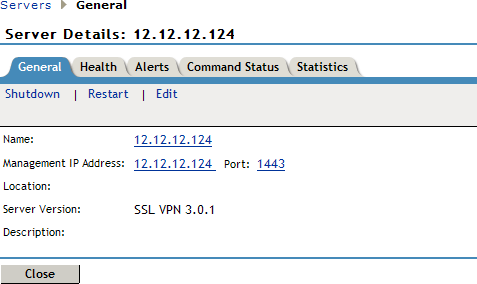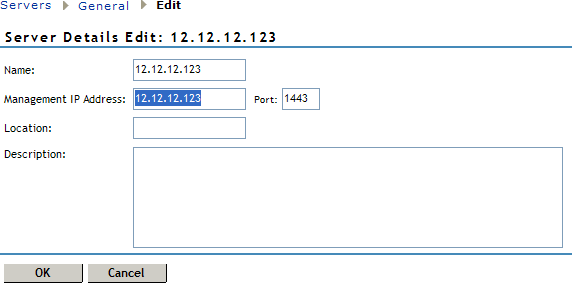19.4 Modifying SSL VPN Server Details
To edit the Gateway information:
-
In the Administration Console, click .

-
Check the information that is displayed and make any necessary changes.
New Cluster: Displays the New Cluster dialog box. You can specify a name for your SSL VPN configuration and assign an Identity Server. When you click , the system displays the Create Cluster Configuration page, which lets you configure how your Identity Servers operate in an Access Manager configuration. For more information on clustering SSL VPN servers, see Section 21.0, Creating a Cluster of SSL VPN Servers.
Stop: To stop the SSL VPN server so that the power can be turned off, select the SSL VPN server, then click .
Start: To start the SSL VPN server, select the SSL VPN server, then click .
Refresh: Click this option to update the list of servers and their health status.
Actions: To delete an SSL VPN server, restart the embedded service provider, or modify cluster membership, select an SSL VPN server, then click .
Name: Displays a list of servers added to the Administration Console. Click the particular server to view or modify its configuration. For more information, see Section 19.4, Modifying SSL VPN Server Details.
Status: Indicates the configuration status of the SSL VPN server. Possible states are pending, update, and current. Current indicates that all configuration changes have been applied. Update indicates that a configuration change has been made, but not applied. Click the link to apply the changes. Depending upon what has been modified, updating the complete configuration might cause logged-in users to lose data and lose their connections. Pending indicates that the server is processing a configuration change, but has not completed the process.
Health: Indicates whether the server is functional. Click the icon to view additional information about the operational status of the server. For more information, see Section 27.0, Monitoring Health of SSL VPN Servers.
Alerts: Indicates if any alert was sent. This option is not available to you if the alert count is 0. For more information, see Section 29.2, Viewing SSL VPN Alerts.
Commands: Indicates the status of commands issued to all servers. For more information, see Section 28.0, Viewing the Command Status of the SSL VPN Server.
Statistics: Indicates the number of active client connections and the time when the server was started. Click to get the statistics information. For more information, see Section 26.0, Viewing SSL VPN Statistics.
Type: Indicates whether the type of SSL VPN that is installed is high bandwidth or low bandwidth.
Configuration: Click in the column of the SSL VPNs page to view and modify the configuration of the SSL VPN server. This page specifies the date and time when the last modification was made and lists the full distinguished name of the user who made the last modification. For more information, see Section III, Configuring SSL VPN.
-
Click the server. The Server Details page is displayed.

The tab of the Server Details page displays information such as name, Management IP address, Port, Location, and the server version of the selected server.
-
Click . The Server Details Edit page is displayed.

-
Check the information and make any necessary changes.
Name: Specify the IP address of the server. This field is mandatory.
Management IP Address: Specify the IP address used to manage the server. If the system on which the agent is installed has multiple IP addresses, you can select one from the drop-down list.
Port: Specify the port used for management. This field is mandatory.
Description: (Optional) Provide a brief description of the purpose of this SSL VPN Gateway or any other relevant information.
-
Click to save changes or click to discard the changes.